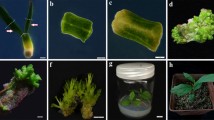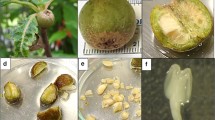Abstract
Commercial plant tissue culture now primarily serves the ornamental horticulture industry. The main pillars of the commercial tissue culture business are scalability of production, cost reduction, limited labor involvement, high quality, and genetic homogeneity of propagated plants. Based on these requirements, the current protocol employs a partially immersed liquid culture medium supported by a flexible aluminum mesh raft with a wire stand to facilitate shoot organogenesis from the horizontally placed root explants and hold the plants upright for shoot multiplication and rooting of Limonium Misty Blue. It is a florist crop that is in high demand as both dried and fresh flower fillers in various floral decorations. The majority of cultivated Limonium or statice cultivars are heterozygous in nature and propagate commercially through in vitro propagation to cater to the huge demand for planting materials needed for flower production. This is the first protocol to describe direct shoot organogenesis from the roots in a liquid half-component of Murashige and Skoog’s (1962) (MS) basal medium supplemented with 1.6 μM NAA and 1.1 μM BA. The regenerated shoots are multiplied and rooted at the same time on the raft in a MS-based liquid culture medium that included 0.44 μM BA and 1.07 μM NAA. In comparison to agar-gelled medium, plants cultured in liquid medium grow more quickly without any signs of hyperhydricity. In liquid medium, a clump of 4–5 shoots is formed from a single shoot explant within 4 weeks and are rooted simultaneously within 6 weeks. On average, seven explants may fit on each raft, so on average, 25 healthy plants are produced from a single bottle. The regenerated plants are easily hardened in the greenhouse, and using ISSR-based molecular markers, the genetic homogeneity of the randomly selected hardened plants can be determined.
Access this chapter
Tax calculation will be finalised at checkout
Purchases are for personal use only
Similar content being viewed by others
References
Bose S, Karmakar J, Fulzele DP et al (2017) In vitro shoots from root explant, their encapsulation, storage, plant recovery and genetic fidelity assessment of Limonium hybrid ‘Misty Blue’: a florist plant. Plant Cell Tissue Organ Cult 129:313–324
Scholten HJ, Pierik RLM (1998) Agar as gelling agent: differential biological effects in vitro. Sci Hortic 77:109–116
Pati PK, Kaur J, Singh P (2011) A liquid culture system for shoot proliferation and analysis of pharmaceutically active constituents of Catharanthus roseus (L.) G. Don Plant Cell Tissue Organ Cult 105:299–307
Wawrosch C, Kongbangkerd A, Köpf A et al (2005) Shoot regeneration from nodules of Charybdis sp.: a comparison of semisolid, liquid and temporary immersion culture systems. Plant Cell Tissue Organ Cult 81:319–322
Latawa J, Shukla MR, Saxena PK (2016) An efficient temporary immersion system for micropropagation of hybrid hazelnut. Botany 94:1
Jones MP, Yi Z, Murch SJ et al (2007) Thidiazuron induced regeneration of Echinacea purpurea L.: micropropagation in solid and liquid culture systems. Plant Cell Rep 26:13–19
Simonton W, Robacker C, Krueger S (1991) A programmable micropropagation apparatus using cycled liquid medium. Plant Cell Tissue Organ Cult 27:211–218
Caplin S, Steward F (1949) A technique for the controlled growth of excised plant tissue in liquid media under aseptic conditions. Nature 163:920–924
Javed R, Yücesan B (2022) Impact of Stevia rebaudiana culturing in liquid medium: elevation of yield and biomass, mitigation of steviol glycosides: comparative analysis of culturing of Stevia rebaudiana in solid and liquid media. Proc Pak Acad Sci B 59:69–75
Ara MT, Nomura T, Kato Y et al (2020) A versatile liquid culture method to control the in vitro development of shoot and root apical meristems of bamboo plants. Am J Plant Sci 11(02):262–275
Ilczuk A, Winkelmann T, Richartz S et al (2005) In vitro propagation of Hippeastrum× chmielii Chm.–influence of flurprimidol and the culture in solid or liquid medium and in temporary immersion systems. Plant Cell Tissue Organ Cult 83:339–346
Nhut DT, da Silva JAT, Huyen PX et al (2004) The importance of explant source on regeneration and micropropagation of Gladiolus by liquid shake culture. Sci Hortic 102:407–414
Chen J, Ziv M (2004) Ancymidol-enhanced hyperhydric malformation in relation to gibberellin and oxidative stress in liquid cultured Narcissus leaves. In Vitro Cell Dev Biol Plant 40:613–616
He Han B, Yu JJ, Yae BW et al (2004) In vitro micropropagation of Lilium longiflorum (Georgia) by shoot formation as influenced by addition of liquid medium. Sci Hortic 103:39–49
Kim EK, Hahn EJ, Murthy HN et al (2003) High frequency of shoot multiplication and bulblet formation of garlic in liquid cultures. Plant Cell Tissue Organ Cult 73:231–236
Wong MY, Chu CY (1995) Effect of medium phase on the growth of rose explants in vitro. J Agric For 44:71–77
Paques M, Bercetche J, Dumas E (1992) Liquid media to improve and reduce the cost of in vitro conifer propagation. In: Abstracts of the international symposium on transplant production systems, pp 95–100, Yokohama, Japan, October 1992
Gangopadhyay G, Das S, Mitra SK et al (2002) Enhanced rate of multiplication and rooting through the use of coir in aseptic liquid culture media. Plant Cell Tissue Organ Cult 68:301–310
Santos Díaz MS, Carranza Álvarez C (2009) Plant regeneration through direct shoot formation from leaf cultures and from protocorm-like bodies derived from callus of Encyclia maria (Orchidaceae), a threatened Mexican orchid. In Vitro Cell Dev Biol Plant 45:162–170
Leyva-Ovalle OR, Bello-Bello JJ, Murguía-González J et al (2020) Micropropagation of Guarianthe skinneri (Bateman) Dressler et WE Higging in temporary immersion systems. 3 Biotech 10:1–8
Ruta C, De Mastro G, Ancona S et al (2020) Large-scale plant production of Lycium barbarum L. by liquid culture in temporary immersion system and possible application to the synthesis of bioactive substance. Plan Theory 9:844–854
Bello-Bello JJ, Cruz-Cruz CA, Pérez-Guerra JC (2019) A new temporary immersion system for commercial micropropagation of banana (Musa AAA cv. Grand Naine). In Vitro Cell Dev Biol Plant 55:313–320
Ramírez-Mosqueda MA, Cruz-Cruz CA, Cano-Ricárdez A et al (2019) Assessment of different temporary immersion systems in the micropropagation of anthurium (Anthurium andraeanum). 3 Biotech 9:1–7
Ramírez-Mosqueda MA, Iglesias-Andreu LG, Favián-Vega E et al (2019) Morphogenetic stability of variegated Vanilla planifolia Jacks. plants micropropagated in a temporary immersion system (TIB®). Rend Lincei Sci Fis Nat 30:603–609
Afreen F (2006) Temporary immersion bioreactor: engineering considerations and applications in plant micropropagation. In: Dutta Gupta S, Ibaraki Y (eds) Plant tissue culture engineering. Springer, Berlin/Heidelberg/New York
Adelberg J (2006) Agitated thin-films of liquid media for efficient micropropagation. In: Dutta Gupta S, Ibaraki Y (eds) Plant tissue culture engineering. Springer, Berlin/Heidelberg/New York
Soccol CR, Mohan R, Quoirin M et al (2004) Use of sugarcane bagasse as an alternative low-cost support material during the rooting stage of apple micropropagation. In Vitro Cell Dev Biol Plant 40:408–411
Prakash S, Hoque MI, Brinks T (2004) Culture media and containers. In: Low cost options for tissue culture technology in developing countries. Proceedings of a technical meeting organized by the Joint FAO/IAEA Division of Nuclear Techniques in Food and Agriculture, Vienna
Afreen-Zobayed F, Zobayed SMA, Kubota C et al (2000) Supporting material affects the growth and development of in vitro sweet potato plantlets cultured photoautotrophically. In Vitro Cell Dev Biol Plant 35:470–474
Afreen-Zobayed F, Zobayed SMA, Kubota C et al (1999) Mass propagation of Eucalyptus camaldulensis in a scaled-up vessel under in vitro photoautotrophic condition. Ann Bot 85:587–592
Kokotkiewicz A, Bucinski A, Luczkiewicz M (2015) Xanthone, benzophenone and bioflavonoid accumulation in Cyclopia genistoides (L.) Vent.(honeybush) shoot cultures grown on membrane rafts and in a temporary immersion system. Plant Cell Tissue Organ Cult 120:373–378
Shukla MR, Piunno K, Saxena PK et al (2020) Improved in vitro rooting in liquid culture using a two piece scaffold system. Eng Life Sci 20:126–132
Seelye JF, Maddocks DJ, Burge GK et al (1994) Shoot regeneration from leaf discs of Limonium peregrinum using thidiazuron. N Z J Crop Hortic 22(1):23–29
Hoagland DR, Arnon DI (1950) The water-culture method for growing plants without soil. In: Agricultural experiment station, 2nd edn. Circular, California
Biswas P, Kumar N (2023) Application of molecular markers for the assessment of genetic fidelity of in vitro raised plants: current status and future prospects. In: Molecular marker techniques: a potential approach of crop improvement. Springer
Konar S, Karmakar J, Ray A et al (2018) Regeneration of plantlets through somatic embryogenesis from root derived calli of Hibiscus sabdariffa L. (Roselle) and assessment of genetic stability by flow cytometry and ISSR analysis. PLoS One 13(8):e0202324
Konar S, Adhikari S, Karmakar J et al (2019) Evaluation of subculture ages on organogenic response from root callus and SPAR based genetic fidelity assessment in the regenerants of Hibiscus sabdariffa L. Ind Crop Prod 135:321–329
Murashige T, Skoog F (1962) A revised medium for rapid growth and bio assays with tobacco tissue cultures. Physiol Plant 15:473–497
Doyle JI, Doyle JL (1990) Isolation of plant DNA from fresh tissue. Focus 12:13–15
Ding G, Zhang D, Yu Y et al (2013) Analysis of genetic variability and population structure of the endemic medicinal Limonium sinense using molecular markers. Gene 520:189–193
Acknowledgments
This work was financially supported by WBHESTB, Govt. of West Bengal [846 (Sanc.)/ST/P/S and T/2G-11/2018; June 19, 2019]; DST-PURSE PROGRAMME, GOI; Savitribai Jyotirao Phule Fellowship for Single Girl Child (UGCES-22-GE-WES-F-SJSGC-16026, UGCES-22-GE-WES-F-SJSGC-16035), RUSA 10 Component (CH&E) [IP/RUSA(C-10)/17/2021 dated 26.11.2021]; and Personal Research Grants (PRG) for teachers and URS provided by the University of Kalyani, West Bengal, India. The assistance of Purbasa Kole during the experiment is gratefully acknowledged.
Author information
Authors and Affiliations
Corresponding author
Editor information
Editors and Affiliations
Rights and permissions
Copyright information
© 2024 The Author(s), under exclusive license to Springer Science+Business Media, LLC, part of Springer Nature
About this protocol
Cite this protocol
Raha, P., Saha, G., Khatua, I., Bandyopadhyay, T.K. (2024). Direct Shoot From Root and True-to-Type Micropropagation of Limonium “Misty Blue” in Partially Immersed Culture on an Aluminum Mesh Raft. In: Ramírez-Mosqueda, M.A., Cruz-Cruz, C.A. (eds) Micropropagation Methods in Temporary Immersion Systems. Methods in Molecular Biology, vol 2759. Humana, New York, NY. https://doi.org/10.1007/978-1-0716-3654-1_11
Download citation
DOI: https://doi.org/10.1007/978-1-0716-3654-1_11
Published:
Publisher Name: Humana, New York, NY
Print ISBN: 978-1-0716-3653-4
Online ISBN: 978-1-0716-3654-1
eBook Packages: Springer Protocols




